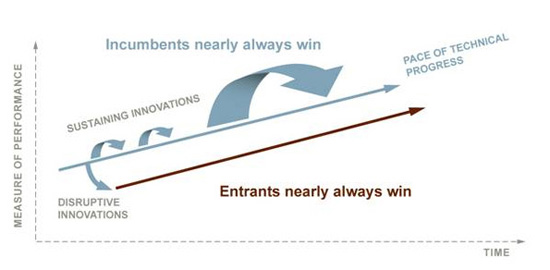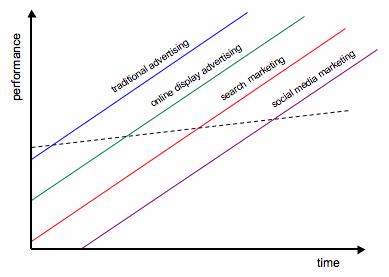The above diagram is from Clay Christensen’s web site with the definition of disruptive innovation.
Ari Paparo, a senior VP at Appnexus, had a terrific article published in Ad Age last week, Don’t Look Now: Classic Disruption Is Taking Place In Advertising, describing the phenomenon of such disruptive technology on agencies and media buying in digital advertising.
(Thanks to my co-founder at ion, Justin Talerico, for forwarding it to me while he was on vacation.)
Ari’s article begins…
Real Time Bidding is the hottest technology in online advertising, and with good reason. By connecting buyers and sellers in real-time, on an impression basis, RTB has enabled an explosion of technology, experimentation, and measurement, resulting in improved results for buyers and yield for sellers. But even with the hype cycle in full force and growth in a hockey-stick patterns, the importance of RTB as a disruptive innovation is largely underestimated.Clayton Christensen first identified the concept of the disruptive innovation in the Innovator’s Dilemma. The basic idea is this: a new technology slowly undermines an existing, dominant technology, by starting out cheaper and “worse,” then slowly improving until it is a full replacement for the dominant one, but with newer, more flexible capabilities, and usually a lower cost basis. Classic examples of disruptive technologies include the PC (which disrupted mainframes and minicomputers) and desktop publishing (which disrupted the print industry).
He goes on to explain that so-called ad exchange technologies were originally such a low-end innovation, considered worse than traditional display buying by interactive agencies. But as these exchanges started to grow — what he labels the second phase of ad exchanges — “RTB-powered buying and selling grew like weeds, rapidly displacing most non-RTB, and simultaneously exchange buying displaced a significant portion of direct remnant sales to ad networks.”
“But even today,” he notes, “the consensus remains that RTB is a great remnant technology, and will never seriously challenge the world of three-martini lunches, faxed IOs, relationships and homepage takeovers. Simply put, it remains ‘worse’ than the incumbent ways of doing business.”
I highly recommend that every marketing technologist read his entire article — both for the story playing out in online advertising, but also as an allegory of other disruptive innovation in marketing.
“The fact that RTB is quickly taking over remnant inventory is, in fact, the first step in a major disruption to the entire online display ecosystem,” he concludes. “The new technology stack will replace, in full, the current way of doing things, and sooner than many may expect.
As a companion piece to Ari’s article, consider this post I wrote a while ago on disruptive innovation in advertising creative.
I made the case that online display advertising had started to disrupt the high-end creative of traditional advertising… and in turn, it was disrupted by even less creative search advertising… which itself has been disrupted by the almost total absence of advertiser-produced “creative” in social media marketing.
Interesting to think of the intersection of these two trends.


Interesting article, thanks for sharing! Looking back at this post from 2011 in 2019 I can only wonder what the next disruptive technology is for media/creative agencies… any ideas?